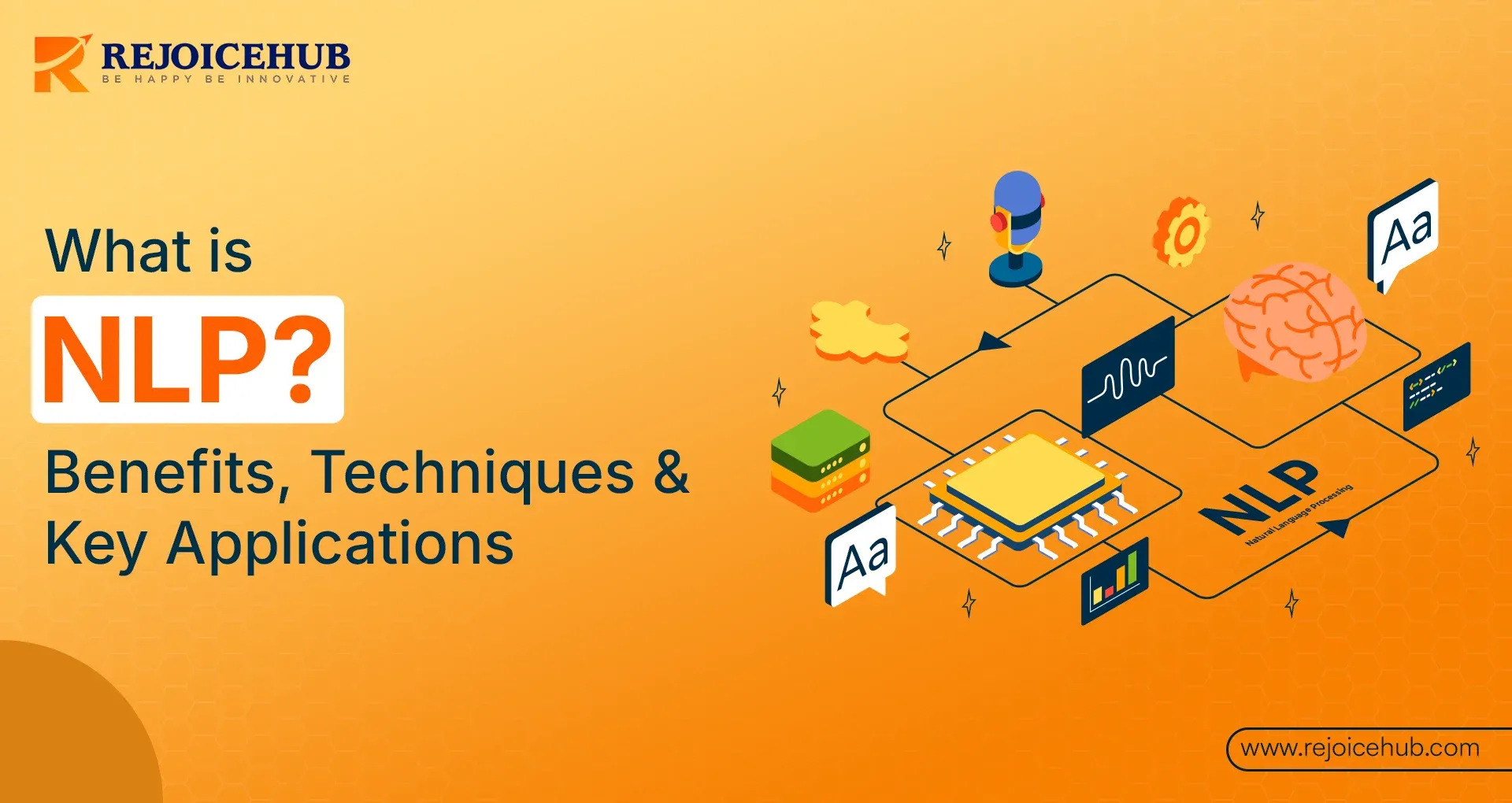
If you've ever asked Siri about the weather today, spoken to a customer support chatbot, or used Google Assistant for any work, you've likely encountered Natural Language Processing (NLP). If you're from a non-science or technology background, the term NLP may seem completely new to you. However, NLP is the core component of today's chatbots and agents. Without it, advanced LLMs like ChatGPT, Cloud, or Grok would never be accessible to the general audience.
And to use LLMs without NLP, you may even need to learn coding and structured languages.
NLP acts as a bridge for communication between humans and machines. NLP is not only useful in communication but also gives the final output in human language.
NLP has played a very important role in modern technology, making advanced technology accessible to the masses. Therefore, in today's article, we will understand NLP in detail, what it is, and how it interacts with humans and gives output.
Quick Summary
Google Gemini has a monthly user base of 350 million users and ChatGPT has 600 million. This gives us a good idea of how widely accessible AI models have become. But you'll probably believe that without NLP (Natural Language Processing), these platforms wouldn't be available to ordinary users today, and you'd have to enter complex codes and prompts to communicate with them.
NLP isn't just being used for chatbots, but it's also being used in businesses and even the critical healthcare sector for various purposes. By 2025, NLP models will have evolved so much that many different types will be available in the market for specific operations.
Our focus in this article:
1. What is natural language processing, and how does it work?
2. What are the benefits and major techniques of NLP?
3. What are the key challenges and use cases we encounter in NLP?
4. What are the future trends of NLP?
What is NLP?
If we understand Natural Language Processing in simple language, then you can call it a subfield of computer science and artificial intelligence, in which the major work is to build communication between humans and machines. For this, they align human languages in structured formats, and according to that, they understand the input and try to reply in human language.
Chatbots, which are NLP-based, can read human input, understand it, and according to that they can also respond to the human. NLP combines computational linguistics with machine learning and deep learning to respond to humans, enabling it to recognise and interpret human language, then generate natural-sounding text or speech.
If you still don't understand what NLP is, let's explain it with an example.
For example: If there is a person in front of you and you have to ask him something, but that person does not know English and you do not know his Spanish language, then in such a situation you will also use tools like "Google Translate", so that both of you can talk naturally in your own language.
You can also consider Natural Language Processing (NLP) as a kind of translator which tries to make the language of machines and humans accessible to both.
Benefits of NLP
I've used many NLP-based tools over the past few years. The primary working model of each tool varies significantly. However, let's explore the benefits you can gain from NLP-based chatbots.
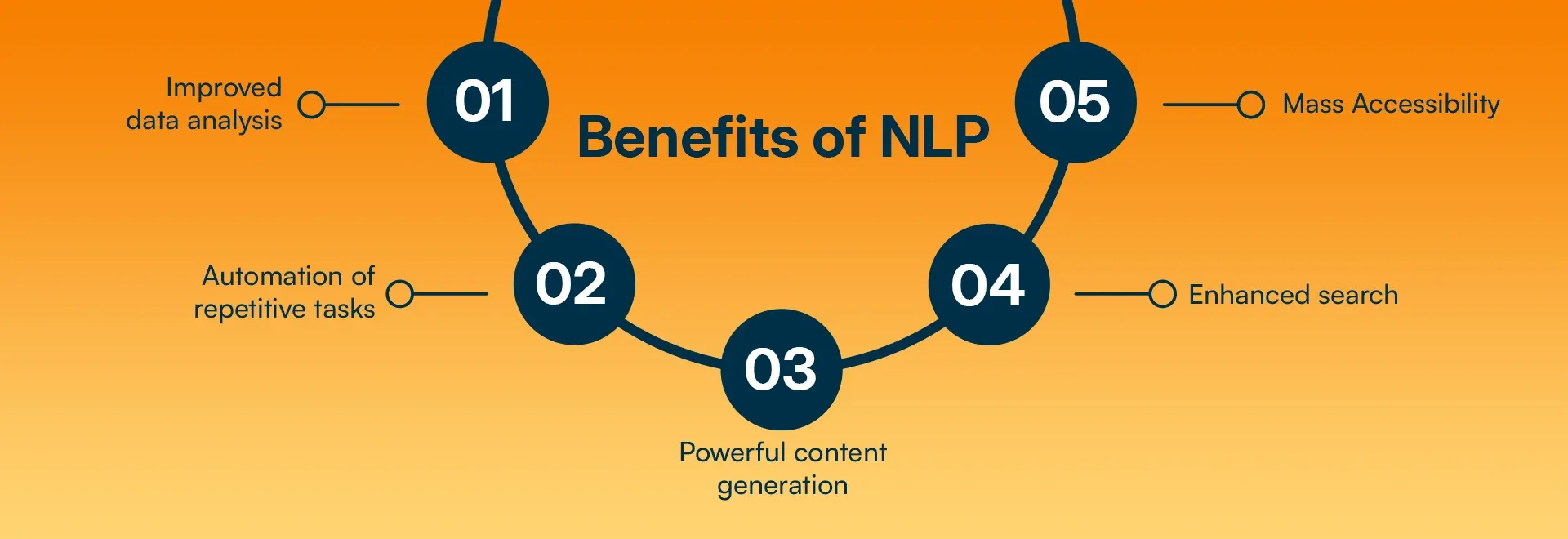
- Improved data analysis: While human language is often unstructured, chatbots can never read raw text. Instead, they uncover patterns in unstructured text, such as customer reviews or social media chatter. This allows businesses to more easily detect trends and sentiments.
- Automation of repetitive tasks: There are many NLP models that allow for the automation of repetitive tasks. This allows you to automate everything from emails to customer queries through NLP models, significantly reducing your time and errors.
- Powerful content generation: Modern, powerful platforms like OpenAI's GPT-4 can generate high-quality articles, product descriptions, and even creative writing at scale, saving companies significant costs.
- Enhanced search: Modern NLP models can effectively understand user intent and deliver accurate and context-aware results to humans, unlike traditional systems that used simple keyword matching techniques.
- Mass Accessibility: Platforms like ChatGPT, Grok or Cloud were designed for professional coders and researchers, as they required complex codes and prompts to handle them, but as NLP started being used, these models became accessible to the mass audience, and in the next few years, when NLP becomes more advanced, then it will be able to handle even regional languages easily.
All these benefits together make NLP an advanced system which helps organizations a lot in their data-driven and customer-centric operations.
How Natural Language Processing (NLP) Works
We've already learned a lot about NLP. Now let's explore how NLP works and how it works.
1. Text Preprocessing: In this process, NLP handles raw data by tokenizing, lowercasing, removing stopwords, and normalizing text. Because human language is unstructured, NLP attempts to structure it through its processing.
2. Text Input and Data Collection: It helps in gathering and storing large volumes of text from sources like websites, social feeds or proprietary documents.
3. Feature Extraction: NLP-based chatbots convert text into measurable features, such as n-grams, syntactic patterns, or semantic embeddings such as Word2Vec or GloVe. This allows NLP to adapt itself to the system.
4. Text Representation: NLP uses a variety of techniques, such as Bag of Words, TF-IDF, or modern word embeddings, and is capable of numerically translating language into sequences. It can also handle algorithms quite effectively.
5. Model Selection and Training: When training NLP, it's crucial to use the right machine learning or deep learning models, such as SVMs, RNNs, or transformers like BERT and GPT. These models are then trained on labeled or self-supervised datasets.
6. Model Deployment and Inference: In NLP, trained models are deployed to perform critical tasks like sentiment analysis, translation, or question answering in real time.
7. Evaluation and Optimization: In this, they continuously measure accuracy so that errors can be avoided. Apart from this, they also pay special attention to precision and recall and further fine tune the hyperparameters and analyzing errors so that they can further enhance the performance.
In a way, you can call this the process of converting unstructured human words into structured ones so that such content can be generated which is machine-readable and after that, they can also give the output in human natural language.
Techniques of NLP
Over the past few years, I've used many NLP-based chatbots and Ai Agents, but whenever I talk to someone who isn't as knowledgeable about technology, they inevitably ask me what NLP is. To understand this, let's learn about its techniques.
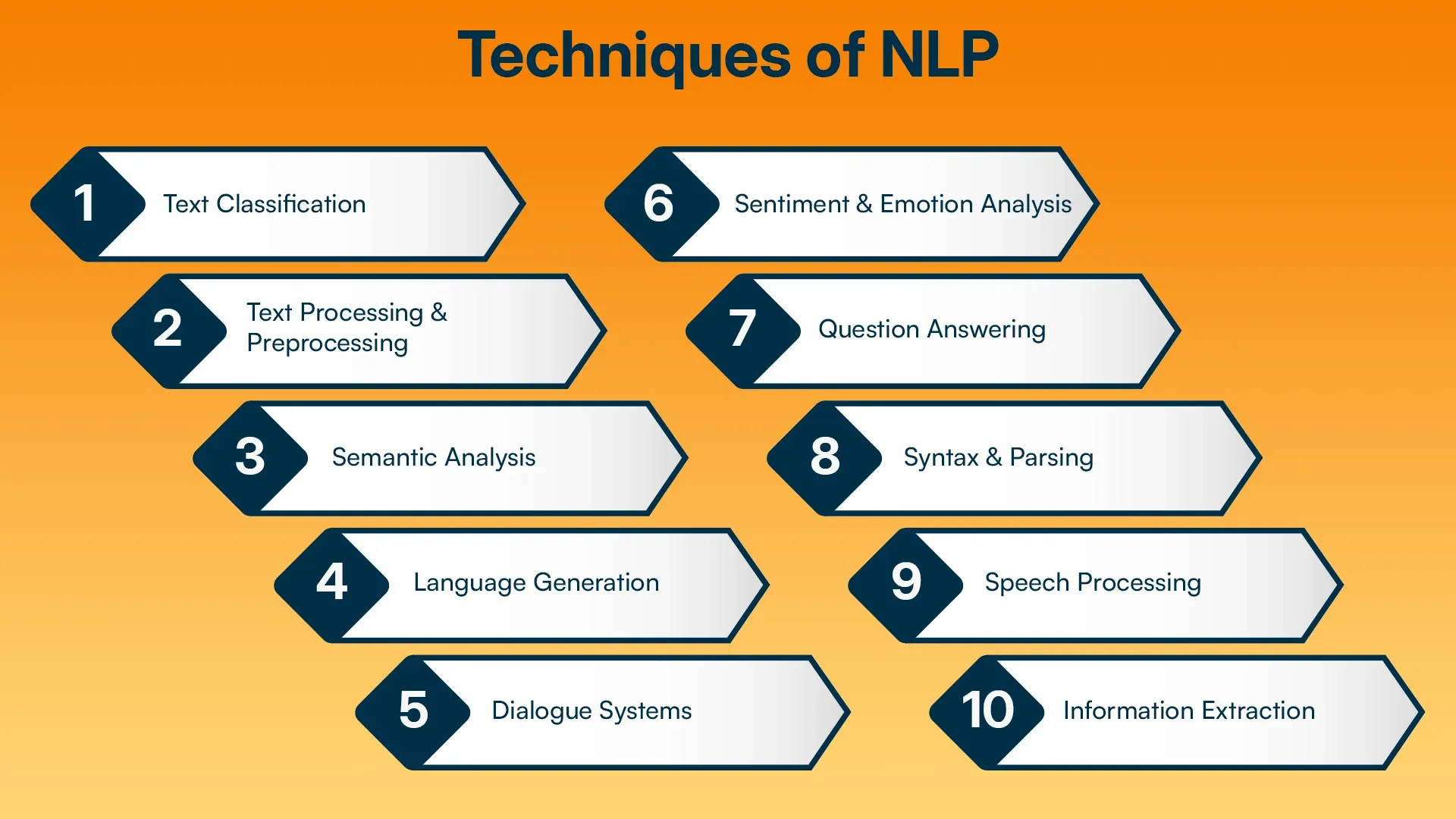
- Text Classification: NLP-based chatbots sort text into categories so they can make appropriate judgments for topic modeling or spam detection.
- Text Processing & Preprocessing: NLP processing uses tokenization, stemming, and lemmatization to maintain groundwork and ensure accurate analysis.
- Semantic Analysis: NLP agents use Named Entity Recognition (NER) to understand words and maintain disambiguation and coreference. Models use machine-based algorithms.
- Language Generation: As we know, machines or chatbots can't understand our language, so they use NLP for text summarization and advanced text generation to generate fluent and human-like content.
- Dialogue Systems: Chatbots and virtual assistants engage in real-time conversations so they can understand slangs and synonyms. I've personally used transformer models quite a bit.
- Sentiment & Emotion Analysis: NLP-based tools can easily detect public opinion and emotional tone. These NLP systems are crucial for customer perception and help brands filter out spam.
- Question Answering: Systems like Google Search or Siri attempt to deliver precise answers to users using retrieval-based or generative methods.
- Syntax & Parsing: NLP uses part-of-speech tagging, dependency, and constituency parsing capabilities to refine and effectively handle grammatical structures.
- Speech Processing: There are many NLP models that support speech-to-text and text-to-speech systems, and this allows for natural results to be produced for humans, which is why Google Assistant and Siri can produce such crisp output.
- Information Extraction: NLP-based tools collect data from entities to understand the context and relationship of large document sets, often used for analysis.
These techniques are used together, allowing NLP-based virtual assistants to effectively understand context and respond naturally based on the context and meaning.
Best NLP Tools and Libraries
Having created and operated a variety of NLP pipelines over the years, one lesson becomes definitive: the tools you use drastically impact both the developmental pace and the quality of a model. What follows is a deeper exploration of each of the most reliable ecosystems and their scenarios of use.
1. NLTK (Natural Language Toolkit)
Most preferred choice of researchers and students, NLTK is a large library of Python offering tokenization, stemming, lemmatization, POS tagging, and corpora built into it like WordNet.
Best use scenario: teaching, rapid prototyping, and exploring fundamental NLP concepts.
My pro tip from experience: whilean excellent learning resource, NLTK slows down at scale, use spaCy or Transformers for production-scale workloads.
2. spaCy
spaCy is a production-level Python library renowned for ultra-high speeds and industrial-strength performance. Pre-trained models of many languages, intrinsic word vectors, and out-of-the-box deep-learning framework integrations with TensorFlow or PyTorch make it a darling of real-time systems.
For example, I once used a multilingual chatbot with a spaCy pipeline and reduced response latency by almost 40%.
3. Stanford CoreNLP
A high-level Java framework with advanced syntactic and semantic parsers, CoreNLP excels in research and business settings where deep linguistic analysis (like dependency and constituency parsing) is a necessity. Important strength: its annotator suite may be pipelined together for complicated pipes.
4. Hugging Face Transformers
It has also democratized access to world-class models from BERT through GPT and LLaMA. With minimal code snippets, developers can deploy or fine-tune world-class transformer models.
Real-world example: when I had to prototype a question-answering service with a quick turnaround time, Hugging Face's pre-trained BERT model reduced dev time from weeks to hours.
Cloud-Based Servers Products like OpenAI's GPT-4 API, Google Vertex AI, and AWS Comprehend eliminate training large models yourself. These are ideal when you are contemplating scalable, enterprise-level NLP with no dedicated infrastructure. Note: These services sometimes come with integrated compliance and security functionalities paramount in sectors such as healthcare or finance.
Applications of Natural Language Processing (NLP)
NLP has become the invisible engine behind many of the tools we use every single day. It quietly powers apps and services that we often take for granted:

- Algorithmic Trading: NLP scans financial news, social media chatter, and even analyst reports to gauge market sentiment and guide trading decisions. By understanding subtle cues in financial language, one can detect early trends that humans might overlook. This enables traders and investment firms to act quickly and gain a competitive edge in fast-moving markets.
- Spam Filters: Email providers rely heavily on NLP to separate genuine messages from junk. Instead of simply blocking emails based on keywords, modern filters understand context, patterns, and even suspicious phrasing. This allows them to catch cleverly disguised spam while ensuring important messages land safely in your inbox.
- Summarizing Information: NLP automatically condenses lengthy articles, research papers, or business reports for quick understanding. Beyond simple shortening, these systems can identify the key arguments and main insights, saving hours of manual reading. Professionals and students alike can focus on what matters without missing critical details.
- Question Answering: NLP powers search engines and voice assistants to respond in natural, conversational language. Whether you ask your phone about the weather or request a recipe from a smart speaker, it's NLP that interprets your intent and delivers relevant answers. Over time, these systems are becoming more context-aware, making interactions feel increasingly personal.
From finance to personal productivity, these applications showcase NLP's ability to cut through information overload and turn raw data into actionable knowledge.
Key Challenges of NLP
Despite incredible progress, my experience shows that NLP still faces significant hurdles that keep researchers and developers on their hand
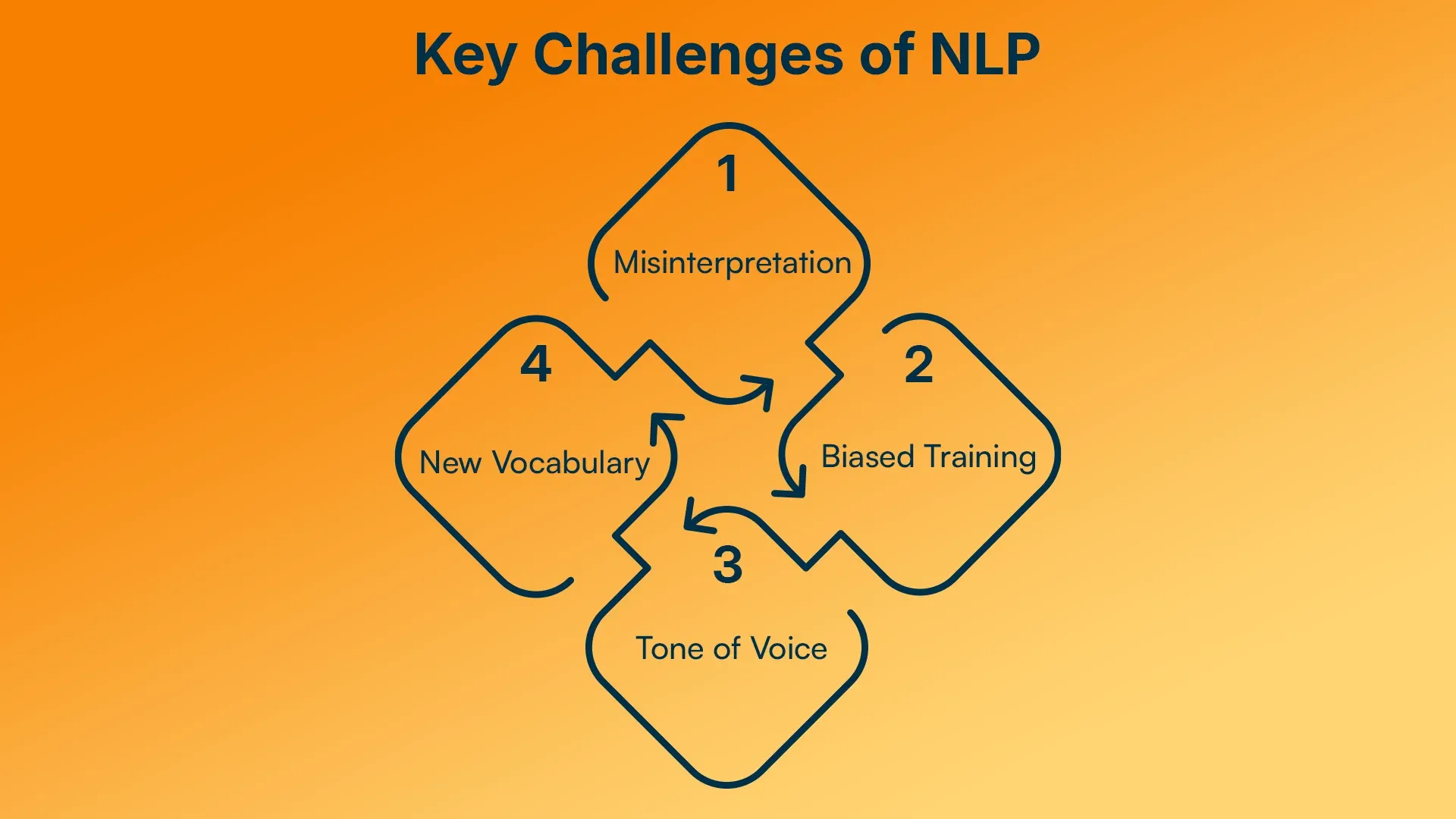
- Misinterpretation: Slang, sarcasm, or background noise can confuse even advanced speech-to-text systems. For instance, a sarcastic "Great job!" might be interpreted literally as praise. Handling these nuances requires models to understand cultural and situational context, something that is still far from perfect.
- Biased Training: Models inherit biases from the data they're trained on, which is a critical risk when serving diverse users. If training data overrepresents certain groups or viewpoints, the system may unintentionally favour or discriminate against others. Tackling bias requires ongoing auditing, diverse datasets, and transparent evaluation.
- Tone of Voice: Subtle cues like irony, emphasis, or emotional inflection remain difficult for machines to decode. Humans effortlessly pick up on these signals, but machines struggle to interpret them without explicit context. This makes tasks like sentiment analysis and conversational AI particularly challenging.
- New Vocabulary: Language evolves constantly, with new slang, memes, and technical jargon emerging almost daily. If models fail to adapt quickly, they risk becoming outdated or inaccurate. Continuous learning and frequent retraining are essential to keep NLP systems relevant in a rapidly changing linguistic landscape.
These challenges remind us that human language is wonderfully complex and that NLP must continually evolve to truly understand and reflect the richness of our communication.
NLP Use Cases by Industry
The influence of NLP spans far beyond just chatbots or search engines. Each industry leverages its unique potential in creative ways:
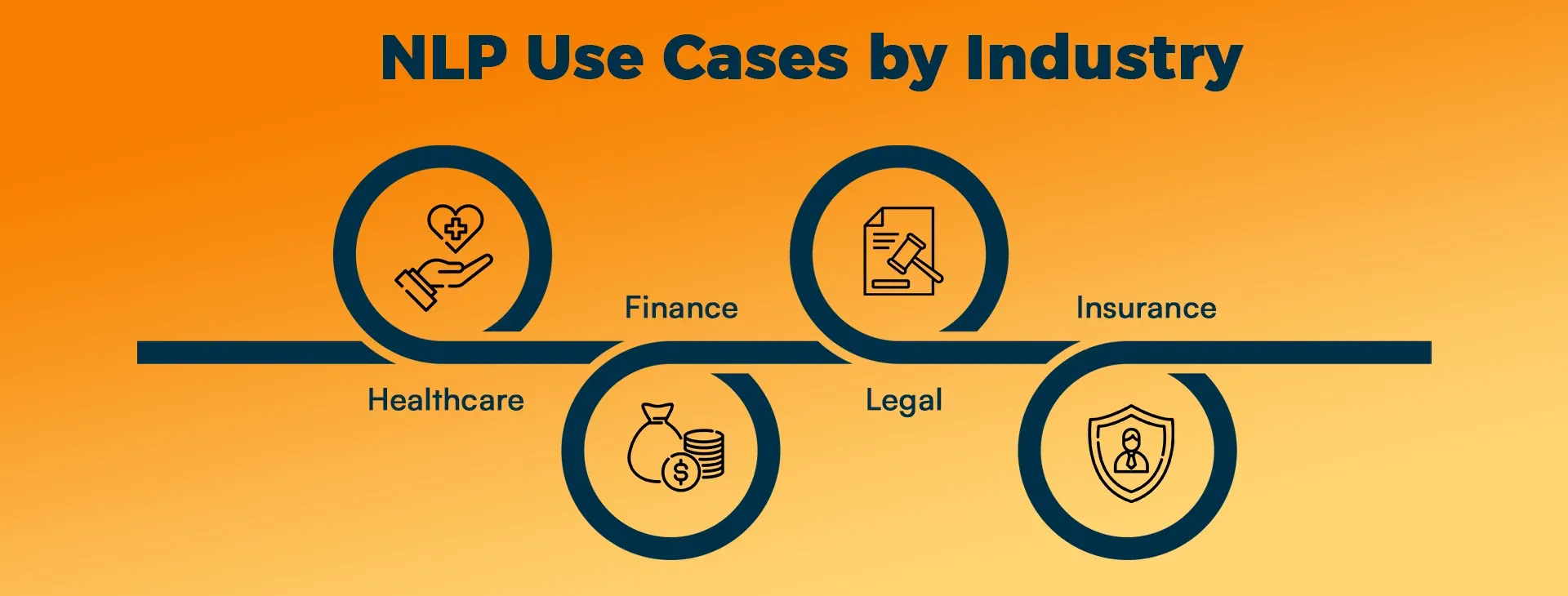
- Healthcare: NLP accelerates the analysis of medical research and patient records, enabling faster and more informed decisions. Doctors can quickly extract critical information from electronic health records, while researchers can sift through thousands of studies to identify trends. This helps improve patient care and supports the discovery of new treatments.
- Finance: NLP helps parse regulatory filings, earnings reports, and even social media chatter for actionable market insights. Traders can spot breaking news before it impacts stock prices, while banks can detect fraudulent transactions through pattern recognition. It's become an essential tool for both risk management and market analysis.
- Legal: In law, NLP automates document review and legal discovery, saving enormous time and cost. Instead of manually combing through thousands of pages, lawyers can instantly find relevant clauses or precedents. This not only increases efficiency but also reduces the risk of human error in high-stakes cases.
- Insurance: NLP detects patterns in claims to optimize processing and spot anomalies. By analyzing customer statements and historical data, insurers can identify fraudulent claims faster and provide quicker settlements for genuine ones. This improves customer satisfaction while keeping operational costs low.
Each industry tailors NLP to its unique data and compliance needs, proving its versatility and its ability to transform how businesses handle information.
Practical Applications of NLP through Case Studies
NLP's impact goes beyond industries. Here are high-impact real-world applications where I've seen real results:

1. Healthcare: Accelerating Diagnostics
Clinics and research centers use NLP with clinical notes and medical literature. For example, one of the cancer-research initiatives I worked with used NLP to process thousands of radiology reports and detect high-risk patients within a period of minutes, a process once took clinicians days.
2. E-commerce: Smarter Product Insights
Massive marketplaces scan millions of product reviews using sentiment analysis. By tracking customers' product descriptions ("runs small," "good build quality"), companies can adjust stock and real-time marketing campaigns and optimize customer satisfaction and revenue.
3. Finance: Real-Time Market Intelligence
Hedge funds feed real-time news and regulatory filings into NLP systems to gauge market sentiment and initiate algo trading. One of the earliest hints from a central-bank announcement can flip trading directions worth millions.
4. Telecom & Customer Support
Multilingual transformer-based chatbots are utilized by major telecom operators to serve billing and network troubleshooting. In one of the implementations I analyzed, NLP-based bots reduced call-center overload by 60% while achieving high customer-satisfaction ratings.
These studies demonstrate how NLP translates unstructured textual data into actionable insight and yields a tangible competitive advantage.
Ethical Considerations and Responsible NLP AI
As an AI professional, I've learned a lot about NLP, as technical correctness is largely responsible for NLP, and it holds equal importance. Let's learn about its four major pillars, which are of paramount importance.
1. Bias and Fairness
If the training data of NLP-based agents or chatbots is biased towards gender, race, or culture, it will significantly degrade their quality.
For instance, sentiment models are trained mostly from Western social media, which may cause them to misclassify Indian language statements.
- Mitigation: Diversify training datasets so that fairness audits can be conducted using explainable AI (XAI) techniques.
2. Privacy and Data Protection
In most critical sectors, NLP data is highly sensitive, whether it's patient records or bank statements.
- Best practice: Companies use anonymization for data protection to keep storage more secure and comply with frameworks like GDPR or India's DPDP Act.
3. Transparency and Explainability
Stakeholders who operate in a particularly regulated environment have some basic requirements.
- Approach: Always choose interpretable models where documentation is available for each step of the model lifecycle.
4. Misuse and Misinformation
Generative texts can be misused as spam, and they also pose a risk of spreading propaganda or deep-fake news. Implement policies, watermark generated texts, and output monitoring to increase security.
Career Outlook and Skills of NLP
The market for NLP or AI-based jobs will reach $250 billion by 2030, which gives us a good idea of the future growth of the NLP sector. Therefore, if you are considering a career in NLP or AI, it is important to understand the skills and job roles of NLP jobs.
Core Technical Skills
- Programming: For NLP jobs, it is crucial to have good programming skills in Python along with knowledge of data libraries like pandas, NumPy, and scikit-learn.
- Machine & Deep Learning: Try supervised/unsupervised learning in RNNs, CNNs, and transformer structures.
- Linguistics: Improve your skills or knowledge in syntax, semantics, and morphology to build improved models.
- Data Engineering: Processing large text is crucial in NLP or AI training, so you should have the skills to build preprocessing pipelines and utilize cloud resources like AWS, GCP, and Azure.
Career Roles
- NLP Engineer / Machine Learning Engineer: As the demand for AI or NLP models increases in the market, NLP engineers will find more opportunities and higher package jobs.
- Data Scientist (NLP focus): Engineers or scientists who are able to integrate and effectively operate NLP in business applications such as customer analytics or fraud detection can earn very high job packages.
- Conversational AI Designer: Professional UI/UX designers who specialize in designing interfaces for chatbots or voice assistants can find very good AI designer jobs.
- Research Scientist: NLP or AI models are still evolving, and in future many more models will also come, for this a lot of deep research is required and that is why there are going to be a lot of job opportunities for Research Scientist in the market.
If your career is in technical or software sector and if you are skilled in your sector then you can get a very good job package and the AI job market is currently worth $60 billion, this gives us a lot to know about the usage of AI and NLP and this number is going to increase further in the future.
Future Scope of Natural Language Processing (NLP)

As technology advances, the future of NLP looks even more exciting and human-like. We are heading toward an era where natural communication with machines will be second nature
- Invisible User Interfaces (UI): Devices like smart speakers will enable seamless voice or text interactions without screens. You'll be able to control appliances, get updates, or perform tasks simply by speaking naturally. This will make technology more accessible to people of all ages and abilities.
- Chatbots and Virtual Assistants; Smarter, always-available assistants will handle complex tasks and nuanced queries. Instead of just answering basic questions, they'll manage schedules, negotiate simple tasks, and even predict what you need before you ask. This will bring a new level of convenience to both personal and professional life.
- Multilingual NLP: Expanding support for regional and minority languages will make technology truly global. From rural communities to international businesses, NLP will break language barriers, allowing seamless communication across cultures and regions. This inclusivity will empower millions of new users to access information and services.
- Smarter Search: Search engines will increasingly understand context and intent, making information retrieval more natural. Instead of typing keywords, users will describe their needs conversationally, and search systems will deliver precisely what they're looking for. This evolution will transform how we interact with the internet.
- With deep neural networks and foundation models advancing rapidly, the next generation of NLP will feel even more human-blurring the line between human conversation and machine understanding.
Conclusion
Over the past few years, I have closely monitored the NLP and LLM platforms, and based on my experience, I can tell you that this is going to be the backbone of future businesses and technologies, as it makes human interaction with machines more seamless.
Frequently Asked Questions
1. Is NLP part of Artificial Intelligence?
Yes, NLP (Natural Language Processing) is a branch of AI. It's a subset of artificial intelligence, focusing on understanding human language using machine language and then providing user-generated output.
2. What is the future of NLP?
In the future, NLP will grow even more and will be able to handle multilingual support more effectively. In addition, NLP will also provide effective virtual assistants. NLP will also be capable of multi-platform support in the future.
3. Can NLP replace human jobs?
I don't think NLP will replace human jobs, as critical thinking requires skilled human employees. However, NLP-based chatbots can certainly handle repetitive tasks like customer support or document processing. Therefore, human employees should improve their skills over time.
4. Which industries benefit most from NLP?
Many businesses have benefited from NLP, but it is primarily used in the healthcare, finance, legal, and insurance sectors, and is mostly preferred for virtually data-driven industries.
5. What is the difference between NLP and NLU?
Natural Language Processing (NLP) is a broad field of artificial intelligence used to understand human language. Natural Language Understanding (NLU) is a subset of NLP whose main focus is to understand the meaning of input and then analyze its intent to produce output in text or speech format.
6. How do transformer models like BERT or GPT improve NLP performance?
Transformers use self-attention mechanisms to capture long-range relationships between words. Older RNNs are capable of processing entire sequences in parallel, making models like BERT and GPT far better at understanding context and producing human-like text.
7. What programming languages are best for NLP projects?
Python is considered a rich ecosystem in the industry standard, with NLTK, spaCy, and Hugging Face being the major ones. But Java is also used for enterprise environments.
8. Can small businesses benefit from NLP without building their own models?
There are many small cloud-based companies like OpenAI GPT-4, AWS Comprehend, or Google Cloud. Natural Language Analytics helps small teams with everything from text summarization to chatbots and training expenses. It also provides custom models to businesses.
